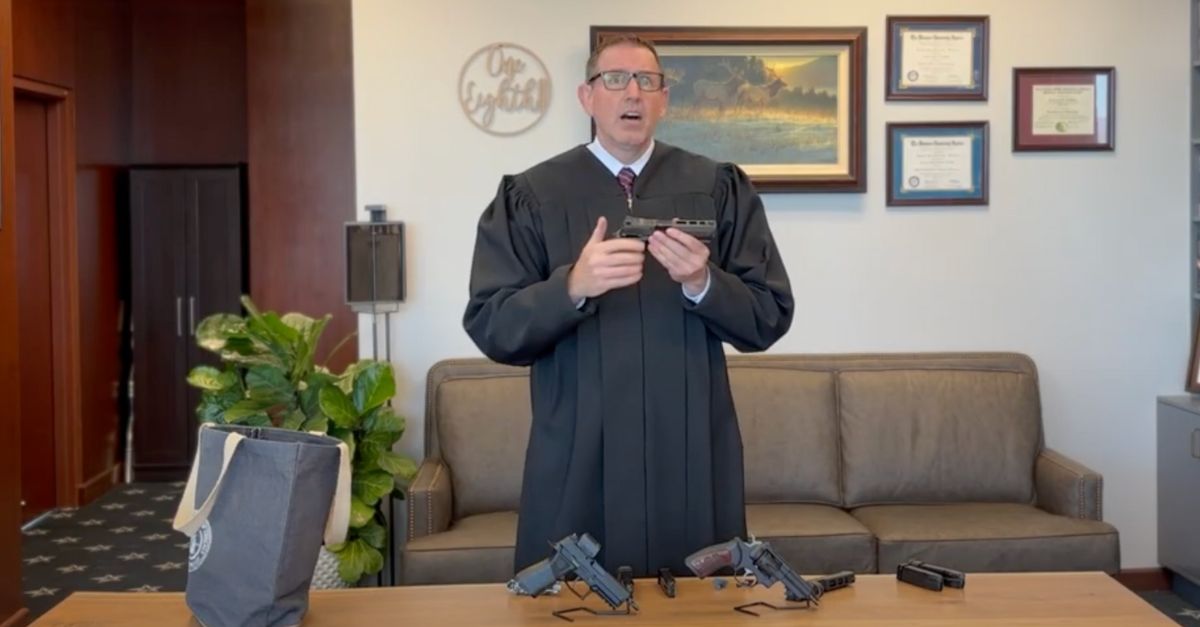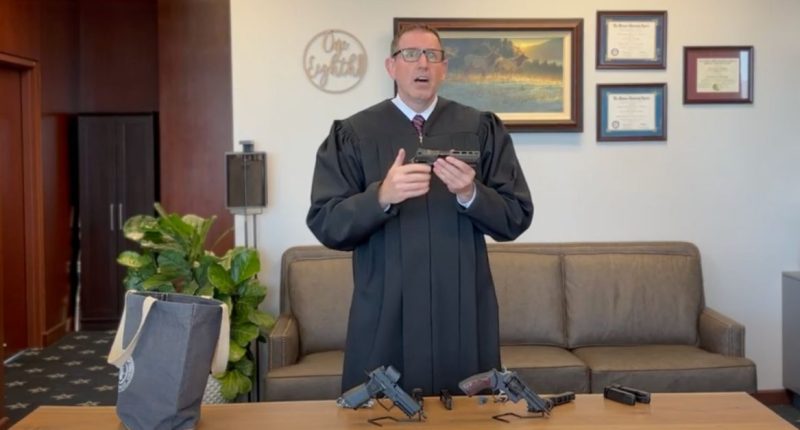
U.S. Circuit Judge Lawrence VanDyke demonstrates the use of handguns in his video dissent in Duncan v. Bonta (screengrab via U.S. Court of Appeals for the Ninth Circuit).
A federal appeals court judge in California appointed by Donald Trump showcased his extensive knowledge of handguns in a rarely-seen video dissent in which he schooled the attorney who argued the case and his fellow appellate judges about how firearms really work.
The full San Fransisco-based U.S. Court of Appeals for the Ninth Circuit ruled 7-4 Thursday to uphold California’s ban on large capacity magazines. The case was a Second Amendment challenge to California’s 2016 law that barred possession of large-capacity magazines. The dispute reached the United States Supreme Court in 2021, and was subsequently remanded following the Supreme Court’s 2022 decision in New York State Rifle and Pistol Association v. Bruen.
The Ninth Circuit ruled Thursday that the ban does not violate Second Amendment rights because large-capacity magazines are not “arms” within the meaning of the constitution, nor are they protected accessories. U.S. Circuit Judge Susan Graber, a Bill Clinton appointee, wrote for the majority, and said the founders chose to constrain the reach of the Second Amendment by protecting the right to bear “arms” — and not the right to bear “arms and accoutrements.”
U.S. Circuit Judges Ryan D. Nelson, Patrick J. Bumatay, and Lawrence VanDyke — all Trump appointees — dissented.
VanDyke, however, not only penned a 23-page dissent — he also provided a “dissent video” in the case in which he demonstrated various firearms from what appears to be an office while dressed in judicial robes.
In the 18-minute video, VanDyke took apart and put together various handguns while making the case that a gun magazine, regardless of capacity, is part of the gun itself and is therefore protected by the Second Amendment.
VanDyke demonstrated by taking a handgun and talking about the difference between a “standard 21-round magazine,” and some other configurations and grips that would be available from the manufacturer. He noted the weight and manufacturing specifications of the pistol, and demonstrated loading the gun to ready it for firing.
VanDyke said that he was illustrating the flaws in the majority’s argument by showing how the large-capacity magazines function as compared with “other parts of the firearm and to this firearm as a whole.”
While doing so, VanDyke commented that part of the reason he was making the video is because “it appeared that counsel didn’t understand what I was asking” during oral arguments.
The judge then went on at length to discuss the gun’s “iron sights” — alignment devices that assist with aiming a gun. He argued that this commonly used sighting system could be replaced with a “red dot optic” that would make the gun “work better” for lawful purposes.
VanDyke ended the video by saying that, “California’s argument, which the majority has unwisely adopted here, is based on the unstated assumption that there is some basic — I guess unadorned without any accessories — firearm that would be protected under the Second Amendment,” and that such a misunderstanding would allow the state to “ban the entire mechanism altogether,” thereby, “forcing everyone to use revolvers or single shot handguns.”
“I hope you can tell from this video that that idea is simply unrealistic and could never be applied in real life,” VanDyke said.
U.S. Circuit Judge Marsha Berzon, a Bill Clinton appointee, penned a concurrence in which she slammed VanDyke for making the video at all.
“Here, I address Judge VanDyke’s novel form of ‘dissent,’” wrote Berzon. “Judge VanDyke’s dissent improperly relies on factual material that is unquestionably outside the record. His source for these beyond the record facts? A video that he recorded, in his own chambers, showing him handling several different handguns and explaining his understanding of their mechanics and operation.”
She went on to call out VanDyke for the impropriety of the video as something that goes beyond opinion and treads into the real of fact and evidence
Second, and more egregiously, Judge VanDyke has in essence appointed himself as an expert witness in this case, providing a factual presentation with the express aim of convincing the readers of his view of the facts without complying with any of the procedural safeguards that usually apply to experts and their testimony, while simultaneously serving on the panel deciding the case. While the facts JudgeVanDyke asserts must be ignored, his wildly improper video presentation warrants additional comment, lest the genre proliferate.
You can watch the full video here.
Love true crime? Sign up for our newsletter, The Law&Crime Docket, to get the latest real-life crime stories delivered right to your inbox.







